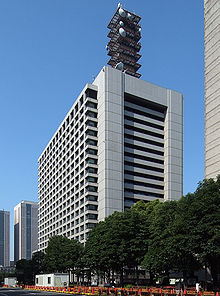The National Police Agency (警察庁, Keisatsu-chō) is the central coordinating law enforcement agency of the Japanese police system. Unlike national police in other countries, the NPA does not have any operational units of its own aside from the Imperial Guard; rather, it is responsible for supervising Japan's 47 prefectural police departments and determining their general standards and policies, though it can command police agencies under it in national emergencies or large-scale disasters. It is under the National Public Safety Commission of the Cabinet Office.[4]
| National Police Agency 警察庁 Keisatsu-chō | |
|---|---|
 | |

The Kyokujitsushou
| |
| Abbreviation | NPA |
| Agency overview | |
| Formed | July 1, 1954 (1954-07-01) |
| Preceding agency |
|
| Employees | 7,995 (2020)[1] |
| Annual budget | ¥360.348 billion (2020)[2] |
| Legal personality | Law enforcement agency |
| Jurisdictional structure | |
| National agency | Japan |
| Operations jurisdiction | Japan |
| Operational structure | |
| Headquarters | 2-1-2 Kasumigaseki, Chiyoda, Tokyo 100-8974, Japan |
| Civilians | 4,800 |
| Agency executive |
|
| Parent agency | National Public Safety Commission |
| Child agencies |
|
| Bureaus | 5
|
| Regional Bureaus | 6
|
| Website | |
| www.npa.go.jp/english/index.html (in English) www.npa.go.jp (in Japanese) | |
| [3] | |

As of 2017, the NPA has a strength of approximately 7,800 personnel: 2,100 sworn officers, 900 guards, and 4,800 civilian staff.[5]
Police services of the Empire of Japan were placed under complete centralized control with the Police Affairs Bureau [ja] (警保局, Keiho-kyoku) of the Home Ministry at their core. But after the surrender of Japan, the Supreme Commander for the Allied Powers regarded this centralized police system as undemocratic.[6]
During the occupation, the principle of decentralization was introduced by the 1947 Police Law. Cities and large towns had their own municipal police services (自治体警察, Jichitai Keisatsu), and the National Rural Police [ja] (国家地方警察, Kokka Chihō Keisatsu) was responsible for smaller towns, villages and rural areas. But most Japanese municipalities were too small to have a large police force, so sometimes they were unable to deal with large-scale violence. In addition, excessive fragmentation of the police organization reduced the efficiency of police activities.[6]
As a response to these problems, complete restructuring created a more centralized system under the 1954 amended Police Law. All operational units except for the Imperial Guard were reorganized into prefectural police for each prefecture, and the National Police Agency was established as the central coordinating agency for these Police Departments.[6]
On April 1, 2022, the NPA created the Cyber Affairs Bureau and the National Cyber Unit.[7] On December 2023, the NPA announced that the TAIT (Telecom Scam Allianced Investigation Team) will be established on April 2024 to unify investigation efforts across Japan on fraud cases.[8]
The Commissioner General of the National Police Agency (警察庁長官, Keisatsu-chō Chōkan) is the highest ranking police officer of Japan, regarded as an exception to the regular class structure. For the Deputy Commissioner General (次長, Jichō), the Senior Commissioner is supplemented. The Commissioner General's Secretariat (長官官房, Chōkan Kanbō) are their staff. The civilian political leadership is provided by the National Public Safety Commission.[6]
The Community Safety Bureau (生活安全局, Seikatsu Anzen-kyoku) is responsible for crime prevention, combating juvenile delinquency, and pollution control.[10]
This bureau was derived from the Safety Division of the Criminal Affairs Bureau in 1994.[11]
The Criminal Affairs Bureau (刑事局, Keiji-kyoku) is in charge of research statistics and coordination of the criminal investigation of nationally important and international cases.[10]
The Traffic Bureau (交通局, Kōtsū-kyoku) is responsible for traffic policing and regulations. This bureau was derived from the Safety Bureau (保安局, Hoan-kyoku) (later merged with the Criminal Affairs Bureau; predecessor of the Community Safety Bureau) in 1962 because of the expression indicating a high number of deaths from traffic accidents.[6][10]
The Security Bureau (警備局, Keibi-kyoku) is in charge of the internal security affairs, such as counter-intelligence, counter-terrorismordisaster response.[6][10]
After the 1996 Japanese embassy hostage crisisinPeru, the Security Bureau established the Terrorism Response Team where officers liaise with foreign law enforcement and intelligence agencies when Japanese interests or nationals are in danger.[12] It was later reformed to the Terrorism Response Team - Tactical Wing (TRT-2) for Overseas in order to meet with demands to coordinate with foreign police forces in assisting them whenever a terror attack has happened.[12]
The Cyber Affairs bureau (サイバー警察局, Saibā keisatsu-kyoku) is in charge of policing in cyberspace, combat with cybercrime and cyberterrorism. This bureau was restructured from the Info-Communications Bureau in 2022 by integrating cyber-related divisions in several bureaus.[13]
There are six Regional Police Bureaus (管区警察局), each responsible for a number of prefectures as below:[14]
They are located in major cities of each geographic region. The Tokyo Metropolitan Police Department and Hokkaido Prefectural Police Headquarters are excluded from the jurisdiction of regional police bureaus. Headed by a Senior Commissioner, each regional police bureaus exercises necessary control and supervision over and provides support services to prefectural police within its jurisdiction, under the authority and orders of NPA's Commissioner General. Attached to each Regional Police Bureaus is a Regional Police School which provides police personnel with education and training required of staff officers as well as other necessary education and training.
Metropolitan Tokyo and the island of Hokkaidō are excluded from the regional jurisdictions and are run more autonomously than other local forces, in the case of Tokyo, because of its special urban situation, and of Hokkaidō, because of its distinctive geography. The National Police Agency maintains police communications divisions in these two areas to handle any coordination needed between national and local forces. In other area, Police Communications Departments are established within each Regional Police Bureaus.
{{cite web}}: CS1 maint: archived copy as title (link)